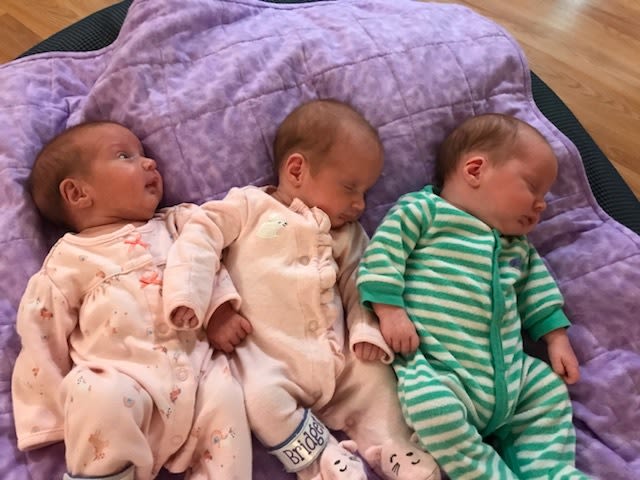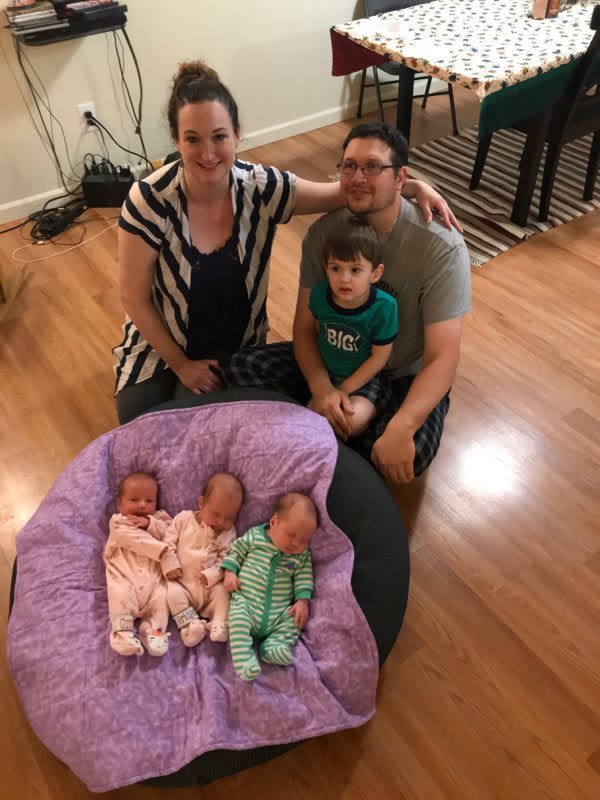Good Things Come in Threes

Maryann Hanks longed for one more baby. Her husband, Cody Hanks, wanted two more. Each got their wish — and then some!
During an ultrasound, the couple learned they were expecting twins, which was an enormous surprise, since there was only one set of multiples in either’s family tree.
“But wait! There’s more!” Maryann relates. “After telling us about the twins, they saw another baby, sort of hiding in there. We were having triplets!”
As if it weren’t rare enough to conceive triplets without fertility treatments, there’s something else that made their situation special — her pregnancy consisted of one pair of identical twins and one “single” baby.
Then there was yet another complication, called TTTS (twin-to-twin transfusion syndrome). This is where abnormal blood vessel connections form in the twins’ shared placenta and allow nutrient-rich blood to flow unevenly between the twins.
“One twin gets too much nutrition, and the other doesn’t get enough. If TTTS is untreated, the outcome can be heart failure, brain damage, and even death,” explains Elizabeth Brass, MD, a perinatologist on Maryann’s care team, along with other doctors who specialize in high-risk pregnancies: Steve Friedman, MD; Jason Hashima, MD; and Suzanne Lubarsky, MD.
Laser surgery, available at only a handful of hospitals across the United States, is commonly the best treatment for TTTS. Kaiser Permanente arranged for Maryann to have the procedure at the University of California San Francisco Medical Center.
Dr. Brass describes the procedure, called selective fetoscopic laser photocoagulation. “It involves a small incision in the mother’s abdomen and inserting a thin fiber-optic scope into the wall of the uterus and into the amniotic cavity of the twin who is being overnourished. Vessels that go from one twin to the other twin are sealed off by a laser beam. The normal vessels that help nourish each twin are left intact.”
After four days at UCSF, Maryanne returned home with just a small bandage over her belly, and the comfort of knowing that her three babies were in good hands.
Several weeks later, on July 19, Maryanne and Cody joyfully greeted their triplets — Ariana, Bridget, and Christine, each in the 4- to 5-pound range — born at Kaiser Permanente Sunnyside Medical Center.
Tonia Berberich, manager of the neonatal intensive care unit, says, “Bringing three babies into the world at once is quite an exciting time for the family, of course, and also for the Labor & Delivery and NICU staff. There is a lot of preparation and great teamwork that goes into making everything happen smoothly. The babies spent time in the NICU, doing skin-to-skin contact with their parents, growing, and learning how to eat.”
“Having one baby isn’t easy, but having three can be exceptionally challenging,” adds Hillary Nicholson, MD, NICU medical director. To help Maryanne and Cody — and all NICU parents — make the transition following the birth of a baby, NICU staff works closely with parents and family members, teaching them how to to care for their babies by reading each baby’s cues.
Happily, the triplets thrived in the NICU and were discharged home three and four weeks later, healthy and excited to join their big brother, 2-year-old Colin.
Dr. Brass says, “It was an honor to take care of Maryann during her high-risk pregnancy. All of us in perinatology are thrilled by her good outcome and healthy babies.”
Looking back on her experience, the mother of four says, “At first, I thought my care team was excessive because they watched me like a hawk, then I was grateful that they were on top of everything and caught the problem early.”
She continues, “Kaiser Permanente hit it out of the ballpark. Every nurse, every doctor, every staff member was amazing. Even the hospital food was a winner. Everyone took excellent care of our little (and expanding!) family. I can’t imagine wanting to receive care anywhere else.”

To learn more about Kaiser Permanente prenatal and postnatal care, go to kp.org/maternity/nw.
